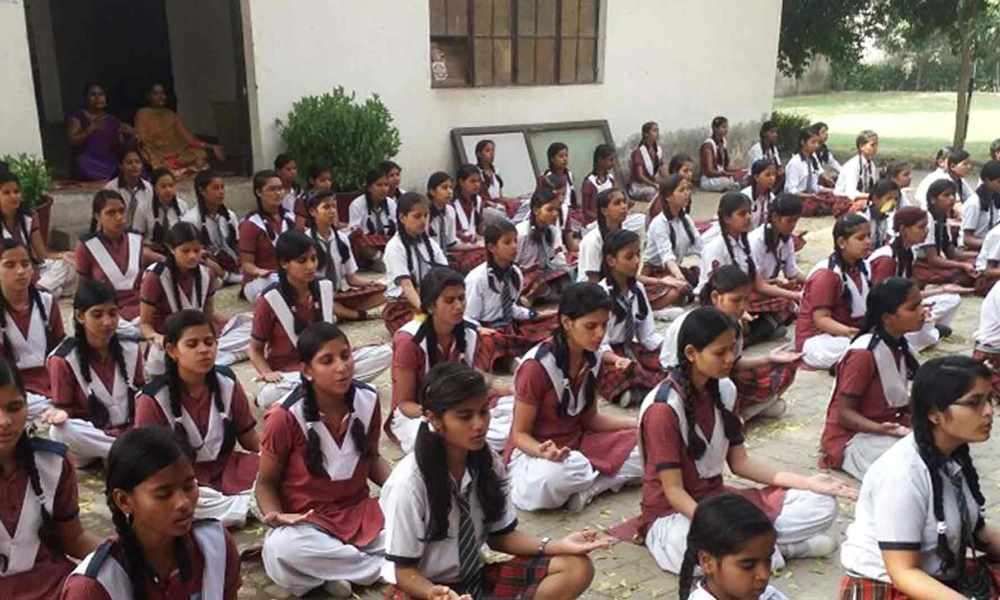Isha Upa-Yoga in Noida’s Rural Schools
Students and teachers in Noida’s rural schools are stepping in, to help make the Isha upa-yoga sessions a success.

Usha Sonkar, who has been coordinating upa-yoga sessions in the Noida region, tells us how students and teachers in the region’s rural schools are stepping in to help make the sessions a success.
Usha Sonkar: One fine morning, I was told that I would be coordinating the Isha upa-yoga sessions in Noida. Without thinking too much, I dived in. Little did I know that thrills and emotions beyond my imagination lay on the road ahead.
We began by conducting a teacher training session for eighty government teachers from fifty rural schools. These teachers would in turn teach their students, through the DVD and training materials we gave them.
A few days later, we began to follow up with each school to see how the sessions were being implemented. Over three weeks, we covered almost forty rural schools and found that many schools did not have electricity, computers and projectors. Far from being equipped with audiovisual equipment, even basic amenities were missing in some schools. Imagine doing upa-yoga in a school where classroom walls are crumbling!
Subscribe
Some schools expected us to conduct the session, when in fact we were only there to observe the teachers. It took quite a bit to explain that their teachers were now trained and that they would conduct the session.
Despite all the challenges, the teachers and principals in these schools were committed to implement the upa-yoga program. Where infrastructure was lacking, they came up with home-grown answers to make things happen under sometimes very trying circumstances. Here are a few of the more ingenious solutions!
At Kisan inter-college, Bhatta Parsaul village, GB Nagar, a computer teacher set up the audiovisual system through jugaad, by assembling a DVD player and using car speakers!
At both Krishi Adarsh inter-college, Dankaur and another college in Dadri, a school teacher brought his own TV and borrowed a DVD drive to conduct a session.
At another remote school, which had no equipment whatsoever, the teacher and a couple of students rigged up the speakers and TV from their homes. The children were very intrigued by their teacher’s enthusiasm and participated whole-heartedly!
In Shyam Singh Smarak Kanya inter-college, Sarfabad, GB Nagar, the principal went home to bring his LCD TV for the session. He participated in the session too, and got everyone’s 100% involvement. After the session, he gleefully said, “More students are coming to the college curious about this DVD yoga. This is increasing attendance!” A student in Bhatta Parsaul seems to agree. He said, “Now we have an important reason to come to school. This will make us learn better.”
A teacher in Kisan Majdoor Adarsh College, Ajaipur, GB Nagar, told us, “Students normally visit school for the mid-day meals, but we see more students coming to school to participate in upa-yoga.”
The training sessions for students are continuing in thirty of the fifty schools. Since most of these schools do not have large halls, the teachers are training students in batches of forty to fifty in classrooms. In four schools, Isha upa-yoga has been made part of the morning assembly.
As we drove into remote villages in Gautam Budh Nagar, we thought about the conditions of government schools and felt bad about it. But the joy and ecstasy that came from teachers, and their involvement was too humbling. It is a wonderful feeling seeing so many children and teachers from rural areas benefit from upa-yoga.
Editor’s Note: Check out the “5-minute Yoga Tools for Transformation” – simple upa-yoga practices for joy, peace, wellbeing, success and more. You can also download the app, or join or host a workshop on International Yoga Day, or train to become a facilitator for the practices.


